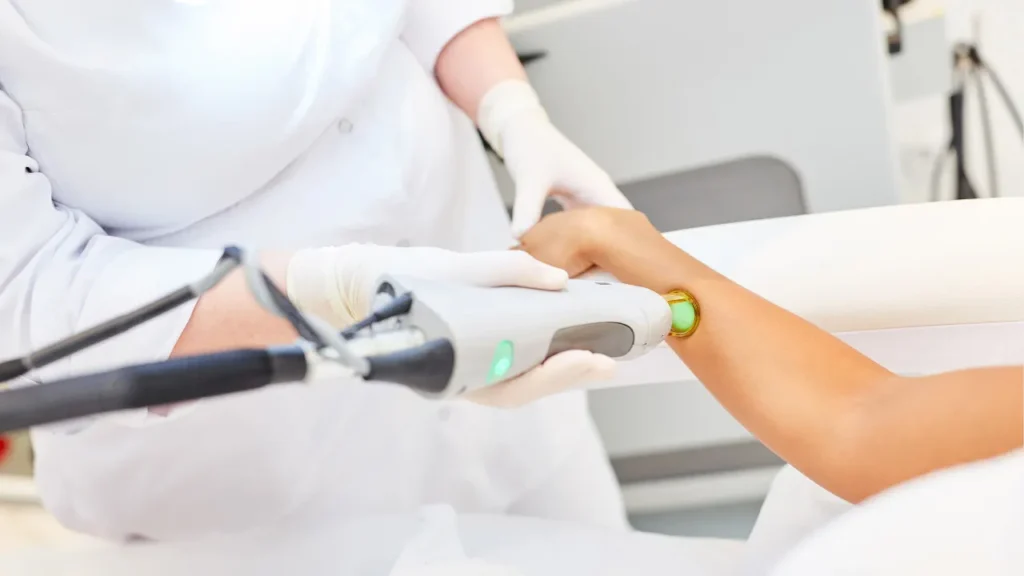Description
A form of sarcoma that develops from the connective tissue associated with the skin is called dermatofibrosarcoma protuberans (DFSP). Although it typically develops within the limbs or torso, it can also occur elsewhere in the body. A firm, painless lump that slowly enlarges over time is how DFSP commonly manifests. Spindle cell growth, which invades the dermis, subcutaneous tissue, and muscles, is one of its defining features.
Historically, DFSP is known to be made up of spindle cells that are of the same size and are grouped in a cartwheel or storiform pattern. To distinguish DFSP from other spindle cell cancers, the tumor cells are often CD34-positive but S100-negative. As DFSP develops, it can become more apparent and protrude from the skin’s surface, therefore giving it the term “protuberans.”
The primary symptom of DFSP is a small, painless lump that develops on the skin and grows over time. The lump could be pink-colored or purple-colored and have a rubbery consistency. As it develops, DFSP has the potential to grow and protrude from the skin’s surface. It is possible that DFSP will occasionally cause bleeding, discomfort, or pain.
You May Also Like:
MUSHROOMS FOR ATHLETES? THIS GAME-CHANGER MAY SURPRISE YOU
FINDING THE BEST TURKEY TAIL MUSHROOM POWDER: 5 TOP BRANDS REVIEWED
Dermatofibrosarcoma Protuberans (DFSP): Description, Causes, And Treatment Protocol is an original (HealthXWire) article.
Possible Causes
Although the precise etiology of DFSP remains unknown, experts hypothesize that it might be brought on by mutations or modifications to the genetic makeup of cells, which would induce uncontrolled cell development and division. Additionally, several research has indicated that radiation exposure can increase the incidence of DFSP. The majority of the time, there are not any obvious warning signs for DFSP.
Exacerbating and Mitigating Factors
The possibility of DFSP can be increased or decreased by a number of factors. Being exposed to ultraviolet (UV) radiation can be associated with a higher risk of acquiring skin malignancies, including DFSP. As a result, it is crucial to exercise sun safety by wearing sun protection apparel, applying sunscreen containing a substantial sun protection factor, along with preventing prolonged sun exposure. Scars or burns caused by trauma in the skin might further increase the likelihood of contracting DFSP. It is essential to safeguard the skin from harm and to get medical help right away if an injury develops.
Regular skin examinations by a dermatologist may help in the early detection of DFSP at which point it is more manageable to treat. The growth of DFSP could be additionally influenced by genetic factors. To lower the chance of acquiring cancer, it is crucial to get frequent medical screenings while maintaining a healthy lifestyle. For instance, smoking can impair immune function and raise the chances of cancer, which also includes DFSP. This possibility can be decreased by quitting smoking.
Diagnosis
Typically, a physical checkup, imaging studies, and a biopsy are used to diagnose DFSP. A doctor will check the skin through a physical checkup for any strange lumps or blemishes. Imaging examinations, such as ultrasounds, CT scans, or MRIs, may be performed to assess the cancer’s severity and ascertain whether it has spread across various body parts. In order to establish the development of DFSP, a biopsy entails taking a tiny sample of tissue off the afflicted area and studying it using a microscope.

Standard Treatment Protocol(s)
Surgical excision using a large margin of healthy tissue is the conventional course of treatment for DFSP. In order to stop cancer from coming back, a margin of skin that is healthy must be removed surrounding the area of skin which includes the dangerous cells. The position and dimensions of the tumor have an impact on the margin’s size. Surgery seeks to totally eliminate the tumor while retaining as much good tissue as is practical. The following are a few of the common treatment methods:
Mohs Micrographic Surgery:
The tumor gets removed using this specific surgical procedure layer by layer, while each layer is promptly checked under a microscope in order to make sure that all cancerous cells have been eliminated. This method offers a high rate of success in totally eliminating DFSP and reducing scarring.
Radiation Therapy:
When a full surgical removal cannot be feasible or there exists a high danger of recurrence, radiation treatments may be used. X-rays with high energy are used in this therapy to destroy cancer cells and stop them from growing.
Chemotherapy:
Generally, chemotherapy is ineffective for the treatment of DFSP, but it can be used when the tumor has spread or when targeted treatment with imatinib has failed. Chemotherapy involves administering medications to the body in order to eradicate cancerous cells.
Follow-Up:
You should have routine follow-up exams after treatment to check for recurrence. The likelihood of recurrence along with the dimensions and position of the tumor can affect how frequently follow-up tests are performed. Physical examinations, imaging analyses, and blood tests are all possible as follow-up assessments.

Treatment Options
For DFSP, there are additional treatment options besides surgery and radiation treatment. The following are some of them:
Topical treatments:
If the tumor is tiny and superficial, topical treatments like ingenol mebutate and imiquimod might be used instead of surgery or alongside surgical excision. Imiquimod, a topical immune reaction modifier, encourages the body’s defenses to go after cancer cells. Topical ingenol mebutate remains a substance that shrinks tumors by inducing the death of cells and inflammation.
Cryotherapy:
Liquid nitrogen is used in cryotherapy to freeze the tumor, killing the malignant cells. A less intrusive alternative for treating tiny, superficial DFSP tumors involves cryotherapy.
Imatinib Mesylate:
This is a medication used in targeted treatment that stops a protein named tyrosine kinase from growing and spreading cancerous cells. It is proven to be successful in the treatment of DFSP that has either returned following surgery or is unable to be completely eliminated by surgery.
Photodynamic Therapy:
A photosensitizing drug is applied to the tumor during photodynamic therapy, and a light source is used to activate it. The photosensitizer that has been activated produces oxygen radicals that kill cancer cells. When a tumor is tiny and superficial, photodynamic therapy might be utilized instead of surgery.
Laser Therapy:
High-intensity light beams are used in laser therapy to kill cancer cells. When a tumor is relatively tiny and superficial, laser therapy might be used instead of surgery to remove it.

Natural and Herbal Remedies:
There is little scientific evidence supporting the efficacy of herbal and alternative treatments for DFSP. The following are some natural treatments for DFSP that are recommended:
- Aloe Vera
It has been demonstrated that aloe vera gel contains anti-inflammatory properties, which can help calm the skin near the tumor site.
- Turmeric
Curcumin, a spice found in turmeric, has been demonstrated to possess anti-cancer effects. Nevertheless, there is no proof that including turmeric in the diet or consuming turmeric supplements can alleviate or cure DFSP.
- Green Tea
Antioxidants included in green tea can help to lessen inflammation and combat cancerous cells. It might improve the effectiveness of radiotherapy and chemotherapy. According to a study published by the Journal of Clinical Oncology, consuming green tea might reduce the possibility of getting some cancers, such as skin cancer.
- Astragalus
For ages, astragalus has been used in traditional Chinese medicine to strengthen the body’s immune system and combat diseases. According to certain research, astragalus might decrease inflammation and increase the efficiency of chemotherapy.
- Milk Thistle
A substance called silymarin, found in the herbal supplement milk thistle, possesses anti-inflammatory and antioxidant properties. According to certain research, silymarin can assist to prevent skin cancer and increase the efficiency of radiation treatment and chemotherapy.
- Essiac Tea
A mixture of herbs known as essiac tea is being used as a form of cancer therapy in alternative healthcare. Essiac tea may have anti-cancer properties, according to certain research, even if there is little scientific evidence to back this claim. Essiac tea constitutes a drinkable substance.
- Mind-Body Therapies
Exercises that promote overall well-being together with stress reduction, which include yoga, acupuncture, and meditation, can boost the body’s own healing mechanisms.
Nutritional Supplements:
Certain nutritional supplements might additionally be useful as simultaneous therapy for DFSP along with natural and herbal medications. Prior to consuming any supplements, you should see your doctor because some nutrients can conflict with standard cancer therapies. The following are a few supplements that have been recommended to facilitate the therapy of DFSP: –
- Vitamin C
Antioxidant vitamin C can help defend the skin against oxidative stress brought on by free radicals. High amounts of vitamin C might possess anti-cancer effects, according to certain research.
- Vitamin D
In addition to being beneficial for bone health, vitamin D can be an anti-cancer. Supplementing with vitamin D may assist individuals with DFSP lower their risk of developing cancer again, according to several research.
- Omega-3 Fatty Acids
Fish oil contains omega-3 fatty acids, which have anti-inflammatory properties. Omega-3 supplements can be useful in lowering inflammation and inhibiting the spread of cancer cells, according to some research.

Conclusion
Dermatofibrosarcoma protuberans (DFSP) can be treated if you follow your doctor’s recommendations, get advice on what natural supplement would work best for you, and what other medicines and foods you may need to either avoid or add to your daily diet. Nevertheless, it is crucial to remember that nutritional supplements shouldn’t be used in place of routine medical treatment.
Additional resources for further reference
https://dermnetnz.org/topics/dermatofibrosarcoma-protuberans
https://my.clevelandclinic.org/health/diseases/24068-dermatofibrosarcoma-protuberans
https://www.aad.org/public/diseases/skin-cancer/types/common/dfsp/treatment
https://medlineplus.gov/genetics/condition/dermatofibrosarcoma-protuberans/
Important Note: The information contained in this article is for general informational purposes only, and should not be construed as health or medical advice, nor is it intended to diagnose, prevent, treat, or cure any disease or health condition. Before embarking on any diet, fitness regimen, or program of nutritional supplementation, it is advisable to consult your healthcare professional in order to determine its safety and probable efficacy in terms of your individual state of health.
Regarding Nutritional Supplements Or Other Non-Prescription Health Products: If any nutritional supplements or other non-prescription health products are mentioned in the foregoing article, any claims or statements made about them have not been evaluated by the U.S. Food and Drug Administration, and such nutritional supplements or other health products are not intended to diagnose, treat, cure, or prevent any disease.
Table of Contents


